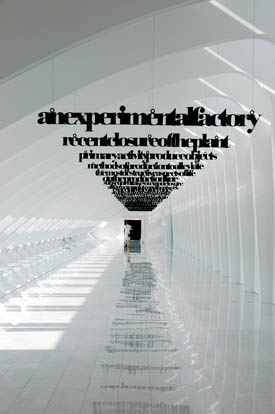I left Oxford four years ago, as a fresh-faced English graduate, clutching my First and ready to take the world by storm. The first things that happened were
1) I got fired several times in quick succession for being more interested in writing than business
2) I wrote the usual abortive Bildungsroman-type first attempt at a novel, and then realised it was rubbish
3) I wrote another one, close but no cigar
4) I stopped trying to ‘be a writer’, and suddenly discovered myself writing more than ever.
But I’ve stopped wanting to write books. Perhaps, in the light of Ben’s post on Vidal and the role of authors, I should explain why.
Part of the problem is that between events 1) and 4) above, I discovered the Internet. I found myself co-editing a collaboratively-written email newsletter that covered the kinds of grass-roots creative and political stuff I wanted to be involved in. I thrashed out swathes of cultural theory in a wiki. I blogged for a while in sonnet form. As a side-effect, I nearly started an art collective in France. I found exciting projects and got involved in them. I’m now working on a startup based on (real and virtual) discussions I had with people I met this way. These days, my writing goes into emails, proposals, and the blogosphere. If I get the yen to write fiction, I do so, in collaboration with friends, on the vintage typewriter in my sitting room.
You could say that I just don’t have time to write a whole book. But it’s not just about time. In the process of learning all these new reasons for writing, I stopped aspiring to be an Author.
To backtrack a bit. In the process of frogmarching me through most of the English literary canon from 10AD to the twentieth century, my tutors put a lot of effort into making me consider the relationship between literary theories and their sociopolitical contexts. So I learned how, in Elizabethan England, the writer’s job was to improve politics by providing aspirational images of political leaders. These days, it looks like sycophancy, but back then they (at least say they) believed that the addressee would be moved by poems describing their ideal self to try and become that self, and that this was a valid contribution to the social good.
Fast-forward a hundred or so years. Print technology is taking off in a big way, and in post-Civil War England, aristocratic patronage is declining, and rhetoric is deeply suspect. So writers such as Pope retroengineered the writings of Shakespeare (and, by implication, their own) to represent an ‘eternal’ canon of ‘great’ writing supposedly immune to the ravages of time. This enabled them to distinguish ‘great’ writing from ‘hack’ writing independent of the political situation, thus conveniently providing themselves with a job description (‘great writer’) that didn’t depend on sucking up to a rich patron under the guise of laus et vituperatio but instead sold directly to the public through the burgeoning print industry.
That, then (if you’ll forgive the egregious over-simplification), is the model of what and who an ‘author’ is. We’ve been stuck with it pretty much since then. It depends on the immutable, printed page, requires authors to turn themselves into a brand in order to make a living by marketing their branded ‘great’ prose to the great unwashed for – of course – the improvement not of the authors but of said unwashed, and supports a whole industry in the production and sale of books.
And then came the Internet. All of a sudden, writing is infinitely reproducible. Anyone who wants to write can self-publish. There are tools for real-time collaborative writing. And yet the popular conception of who or what an Author is still very much alive, in the popular mind at least. The publishing industry, meanwhile, has responded to the threat posed by the Net by consolidating, automating, and producing only books guaranteed to sell millions.
So I found myself, a few years out of university, considering the highly-industrialised modern print industry, in the context of the literary theories and social contexts that have created it. And comparing it to the seemingly boundless possibilities – and attendant threats to intellectual property as an economic model – offered by the Internet. And once I’d thought it through, I stopped wanting to author books.
I’m 27. I write well. I have plenty to say. I ought to be the ‘future of the book’. But I want to introduce myself on if:book by proposing that perhaps the future of the book is not a future of books. Or at least it’s not one of authorship, but of writing. Now, please don’t get me wrong: I don’t think print publishing has nothing to offer. I’m an English graduate. I like the physicality of books, the way you can annotate them, the way they start conversations or act as a currency among friends. But I feel deeply that the print industry is out of step with the contemporary cultural landscape, and will not produce the principal agents in the future of that landscape. And I’m not sure that ebooks will, either. My hunch is that things are going two ways: writers as orchestrators of mass creativity, or writers as wielders of a new rhetoric.
Collaborative writing experiments such as Charles Leadbeater’s We-Think venture begin to explore some of the potential open to writers willing to share authorship with an open-sided group, and able to handle the tools that facilitate that kind of work.
Perhaps less obviously, the Elizabethans knew that telling stories changed the cultural landscape, and used that for political purposes. But we live – at least ostensibly – with the Enlightenment notion that storytelling is not political, and that the only proper medium for political discussion is reasoned argument. And yet, the literary theories of Sidney are the direct ancestors of the modern PR and marketing landscape. Today’s court poets work in PR.
What, then, happens when writers choose to operate outside the strictures of the print industry (or the PR copywriting serfdom that claims many of them at the moment) and become instead court poets for the cultural, social, political interest groups of their choice? What happens when we reclaim rhetoric from the language of ‘rationality’ and ‘detachment’? Can we do that honestly, and in the service of humanity?
I find myself involved in both kinds: writing as orchestration/quality control, and writing as activist tool. But in both cases, I remain unsatisfied by the print industry’s feedback loop of three to five years from conception to publication. So instead, I co-write screenplays, proposals, updates. I write emails to my collaborators; I blog about what I’m up to; I tell stories designed to reproduce virally via the ‘Forward’ button. Perhaps foolishly, I still dream of changing the world by writing. And I want to be around when it happens.
Category Archives: collaboration
the power of collaboration and remix culture — the exquisite corpse goes video
Yet one more reason to check in to Alex Itin’s remarkable blog if you haven’t recently or ever. As you may have read here several weeks ago, alex started a group on Flickr, The Library Project, for people to post works that have been created by two or more artists, building serially on each other’s efforts. Last October Alex posted a beautiful video he made as an homage to the mystical Alpine light know as die alpen lumen. In a nod to the exquisite corpse form of The Library Project, a Japanese artist, Eat A Bug, posted a film he made in response. Serious kudos to alex and all his fellow artists who are demonstrating the power of collaboration and remix culture.
the library project: a networked art experiment
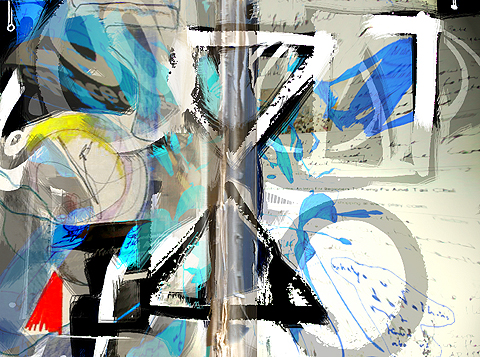
Digital collaboration with me-jade, dou_ble_you and others in the Flickr Library Project
As he recently reflected upon here, Alex Itin has long been working at the border zones of art forms, moving in recent years to the strange intersection of paint and pixels. His blog is one of the most wildly inventive uses of that form, combining blazing low-res images of his paintings with text, photographs, short films, animated GIFs and audio mashups. All of this is done within the constraints of the blog’s scroll-like form — a constraint which Alex embraces, even relishes. I sometimes imagine the scroll endlessly emitting from Alex’s head like tape from a cash register, a continuous record of his transactions with the world.
ITIN place has been on the web for nearly two years now. In his second year, Alex began to explore new avenues out of the blog, establishing a presence on social media sites like Flickr, YouTube, Vimeo (a classier YouTube) and MySpace. Through these networked rovings, Alex has found a larger audience for his work, attracting new “readers” back to the blog where the various transmitted videos and images are reassembled in the scroll. He’s also established relationships with a number of other artists making interesting use of the web, particularly on Flickr and Vimeo. Recently, Alex invited a number of folks from the Flickr community to participate in a collaborative art project — a kind of exquisite corpse game via post. Here’s Alex:
The idea is that one artist takes a hardcover from a book, tears out the pages and draws in one half (or half draws in both halves) of the binder/diptyque. In a nod to Ray Johnson, the two books are mailed (swapped) and Each of these will be finished by the other. The results are posted in a Flicker group called (what else) The Library Project. From this group, hopefully a show will be curated for New York, or Paris, or Basel, or Berlin, or wherever anyone wants to show this project. It should be deliciously portable… get working…get collaborating…get reading!
As of this writing, the Library has racked up 278 members and has 205 images in its pool. A few of these are collaborations that have already made their trek across land, sea and air, others are purely digital combinations, while still others are simply book-inspired works submitted in the spirit of the project.
Alex has been documenting the process on his blog, weaving in some of the images. Styles combine, narratives emerge. In one video (excerpted here) he films himself receiving his first half-completed book from a Canadian artist known as driftwould. He unpacks the drawings and lets out a “wow,” than a sort of humbled sigh. It’s a nice moment of return to the physical world after several years of probing the digital ether.
And here’s how that turned out:
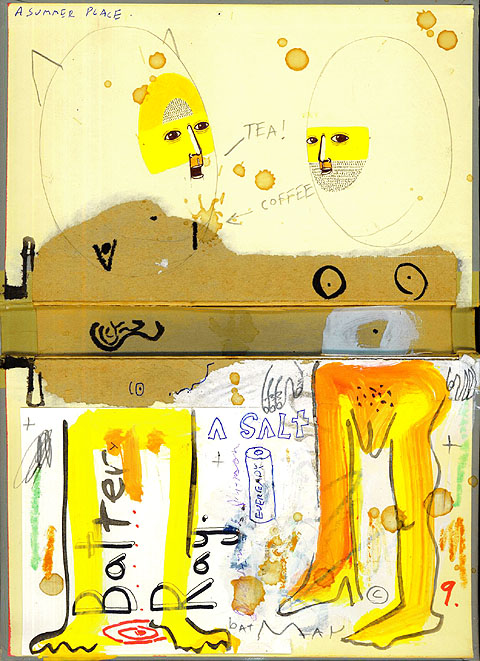
Read Alex’s documentation here and here.
Stay tuned for more — the project has only just begun. Plus, we’ve begun designing a fantastic new interface for Alex’s blog archives, which we’ll talk more about soon.
wikimania day 1: wrap up
 There was something of a valedictory feeling around Wikimania yesterday, springing perhaps from Jimmy Wales’s plenary talk: the feeling that a magnificent edifice had been constructed, and all that remained was to convince people to actually use it. If we build it, they will come & figure it out. Wales declared that it was time to stop focusing on quantity in Wikipedia and to start focusing on quality: Wikipedia has pages for just about everything that needs a page, although many of the pages aren’t very good. I won’t disagree with that, but there’s something else that needs to happen: the negotiation involved as their new technology increasingly hits the rest of the world.
There was something of a valedictory feeling around Wikimania yesterday, springing perhaps from Jimmy Wales’s plenary talk: the feeling that a magnificent edifice had been constructed, and all that remained was to convince people to actually use it. If we build it, they will come & figure it out. Wales declared that it was time to stop focusing on quantity in Wikipedia and to start focusing on quality: Wikipedia has pages for just about everything that needs a page, although many of the pages aren’t very good. I won’t disagree with that, but there’s something else that needs to happen: the negotiation involved as their new technology increasingly hits the rest of the world.
This was the narrative arc traced by Larry Lessig in his plenary: speaking about how he got more and more enthusiastic about the potential of freely shared media before running into the brick wall of the Supreme Court. At that point, he realized, it was time to regroup and assess what would be politically & socially necessary to bring free media to the masses. There’s something similar going on in the wiki community as a whole. It’s a tremendously fertile time technologically, but there are increasingly social issues that scream for engagement.
One of the most interesting presentations that I saw yesterday afternoon was Daniel Caeton’s presentation on negotiating truth. Caeton’s talk was based on his upcoming book entitled The Wild, Wild Wiki: Unsettling the Frontiers of Cyperspace. Caeton teaches writing at California State University in Fresno; he experimented in having students explore & contribute to the WIkipedia. The issues that arose surprised him. His talk focused on the experiences of Emina, a Bosnian Muslim student: she looked at how Bosnian Muslims were treated in the Wikipedia and found immensely diverging opinions. She found herself in conversation with other contributors about the meaning of the word “Bosniak”. In doing so she found herself grappling with the core philosophy of Wikipedia: that truth is never objective, always in negotiation. Introducing this sort of thinking is something that needs to be taught just as much as Wiki markup syntax, though it hasn’t had nearly as much attention.
Today there’s a whole track on using Wikis in education: I’ll be following & reporting back from that.
shirky (and others) respond to lanier’s “digital maoism”
Clay Shirky has written an excellent rebuttal of Jaron Lanier’s wrong-headed critique of collaborative peer production on the Internet: “Digital Maoism: The Hazards of the New Online Collectivism.” Shirky’s response is one of about a dozen just posted on Edge.org, which also published Lanier’s essay.
Shirky begins by taking down Lanier’s straw man, the cliché of the “hive mind,” or mob, that propels collective enterprises like Wikipedia: “…the target of the piece, the hive mind, is just a catchphrase, used by people who don’t understand how things like Wikipedia really work.”
He then explains how they work:
Wikipedia is best viewed as an engaged community that uses a large and growing number of regulatory mechanisms to manage a huge set of proposed edits. “Digital Maoism” specifically rejects that point of view, setting up a false contrast with open source projects like Linux, when in fact the motivations of contributors are much the same. With both systems, there are a huge number of casual contributors and a small number of dedicated maintainers, and in both systems part of the motivation comes from appreciation of knowledgeable peers rather than the general public. Contra Lanier, individual motivations in Wikipedia are not only alive and well, it would collapse without them.
(Worth reading in connection this is Shirky’s well-considered defense of Wkipedia’s new “semi-protection” measures, which some have decried as the death of the Wikipedia dream.)
I haven’t finished reading through all the Edge responses, but was particularly delighted by this one from Fernanda Viegas and Martin Wattenberg, creators of History Flow, a tool that visualizes the revision histories of Wikipedia articles. Building History Flow taught them how to read Wikipedia in a more sophisticated way, making sense of its various “arenas of context” — the “talk” pages and massive edit trails underlying every article. In their Edge note, Viegas and Wattenberg show off their superior reading skills by deconstructing the facile opening of Lanier’s essay, the story of his repeated, and ultimately futile, attempts to fix an innacuracy in his Wikipediated biography.
Here’s a magic trick for you: Go to a long or controversial Wikipedia page (say, “Jaron Lanier”). Click on the tab marked “discussion” at the top. Abracadabra: context!
These efforts can also be seen through another arena of context: Wikipedia’s visible, trackable edit history. The reverts that erased Lanier’s own edits show this process in action. Clicking on the “history” tab of the article shows that a reader — identified only by an anonymous IP address — inserted a series of increasingly frustrated complaints into the body of the article. Although the remarks did include statements like “This is Jaron — really,” another reader evidently decided the anonymous editor was more likely to be a vandal than the real Jaron. While Wikipedia failed this Jaron Lanier Turing test, it was seemingly set up for failure: would he expect the editors of Britannica to take corrections from a random hotmail.com email address? What he didn’t provide, ironically, was the context and identity that Wikipedia thrives on. A meaningful user name, or simply comments on the talk page, might have saved his edits from the axe.
Another respondent, Dan Gillmor, makes a nice meta-comment on the discussion:
The collected thoughts from people responding to Jaron Lanier’s essay are not a hive mind, but they’ve done a better job of dissecting his provocative essay than any one of us could have done. Which is precisely the point.
on collaborating with the reader
I’ve been thinking a lot about the idea of reader collaboration, prior to GAM3R TH3ORY‘s publication but to a good deal in response to its impending arrival. This notion clearly means that after the author has done one thing, the “book” becomes the accumulation of author’s and readers’ contributions.
So I’ve been thinking about collaboration. My starting point was something mentioned on my visit to the Institute — that the book’s source needs to be distributed, and it can be altered by the reader. (This is a very big idea, btw, and it’s radically altered my notion of what an e-book format’s obligations are. But that’s another discussion.)
SInce Sophie is an authoring tool, I thought, Why don’t I author something and really see what it can do? So I’ve been working with my own notion of what a book would be like that isn’t wholly limited by its medium being print. And I thought maybe I should let Sophie’s developers in on my ambition so that there’s a possibility that the features I’m envisioning might be included in the program, at least at some point in the future.
I think it’s easiest to understand my notion of collaborating with the reader by describing my work-in-progress.
So the basic notion is fairly simple, realizable already in Flash, say, or SVG:
Imagine a story, with multiple tracks. (I’m actually envisioning a short book, so let’s say 16 or 24 pages and 5 tracks.) On any page, you can go to the next or previous page. Or you can change tracks and see the next or previous page from some other track. It seems just like a 24-page book, except that the 5 tracks provide variations on what is on each page.
That’s not too exotic. And I don’t stray too far from this notion.
The first thing I’d like to do is provide multiple series of illustrations for each track. So track A might display what i call the French illustrations, or the English, or the Klee, and so on. Thus the first capability I would want to see in my authoring/reading tool is a way to change which illustration (or series of illustrations) displays within each track. You still go backwards and forwards, but maybe I like Van Gogh’s illustrations and you like Ansel Adams’. Perhaps I should mention at this point that it’s a children’s book, so I’m not casually speaking about illustrations. They are the central aspect.
The next thing I’d like to do is to allow the reader to supply illustrations, for any page (in any track), and supplant the author’s (or publisher’s) illustrations. So that perhaps my book comes with 4 series of illustrations for each track, but a reader could add many others. If these series were shared (upload your own, download others’), then perhaps you have 9 series for track A and I have 23. There has to be an easy way for the plugging in pieces, which is more on the level I’m expecting a reader to manage, as opposed to the full set of tools the author will access.
With this, the collaboration with the reader becomes two-fold — first the creation can be shared: make your own illustrations. Then, second, each individual instance becomes distinctive. If we trade “copies,” then we see the distinctive choices we each have made. Each instance is unique, especially as it contains series of illustrations that are not shared/distributed at all. In a way this reminds me of the trading card games that my ten-year-old and his friends play. They all purchase the same cards, each possessing hundreds of cards, and collect them into unique decks that they each admire and study (and then compete against, the duel being paramount). Moreover, each has some cards that none of the others has.
In addition to accepting individual illustrations or whole series of illustrations, the book should allow its text to be edited and alternate versions selected for display. I’m not sure whether one text track would be read-only, or if clicking some button would restore the text to its default form in some track, but I’d expect the author’s initial, unedited version should be retrievable in some way.
I’m far less concerned about the text than I am about this capability with illustrations, btw.
Since my project book is intended for children, I’ve thought a lot about the nature of collaboration with them. In this instance, I think will use little or no animation — it’s not an equal collaboration if the initiating author can do tricks to gain attention that the collaborating reader cannot manage. And that is one thing that makes this a book and not an animation or a cartoon and yet still strives to keep its electronicity high.
And my effort at collaboration is more like a teacher’s — here, you write/draw something, and we’ll replace what I’ve done. Perhaps in the end all the words and pictures are yours. My role was to get you started and to provide the framework. But every new collaborator can begin with the pristine master copy that anyone can access (or maybe they’ll start with a local, already altered variant that the teacher gives them). It hasn’t escaped my notice that in fact the collaboration might be between author and a class of students, not just one reader.
So. Likely as not, this first version of Sophie won’tt contain this addition/substitution capability, or perhaps not to the extent I describe. But I hope it can be added to the future feature set, or hooks anyway that will enable some plug-in to provide this capability. Because this type of collaboration seems to me to be essential.
* * *
It seems a natural expectation that a book constructed of multiple units might have multiple paths through it.
In the case of this children’s book, I don’t expect that going from track-A-page-1 to D3 to B4, and so on, is going to provide anything useful.
But I can clearly envision publications — a guidebook, a cookbook, a college course schedule, an anthology of poetry, a collection of photographs, the Meditations of Marcus Aurelius, the Sayings of the Desert Fathers — in which a reader (or a teacher) may beneficially provide paths that an author overlooks. (Each of these examples of course is an instance of wholly independent units.)
In fact, I expect that Sophie’s envisioneers have thought of such circumstances already, but I raise it here as a collateral issue — collaboration with the reader must inevitably involve everything an author touches: the text, the development of the ideas, the sequence in which they are conveyed, how they are illustrated, the conclusions drawn. In a true collaboration, the author becomes something more like a director, operating perhaps at a remove (how active will the author be in reshaping the book after its publication?). Or maybe the director analogy is too strong; perhaps it’s more like an organizer — the Merry Pranksters, Christo, Lev Waleska — who launches his/her book like a vehicle (like Voyager) and then simply rides its momentum.
Once we make the book more collaborative, we remake what it means to author a book, and the creation of a book itself may come to be something more like a play or a movie or a dance, with multiple, recognized contributors.
I’m wondering how far Sophie goes in anticipating these ideas.
on ebay: collaborative fiction, one page at a time
Phil McArthur is not a writer. But while recovering from a recent fight with cancer, he began to dream about producing a novel. Sci-fi or horror most likely — the kind of stuff he enjoys to read. But what if he could write it socially? That is, with other people? What if he could send the book spinning like a top and just watch it go?
Say he pens the first page of what will eventually become a 250-page thriller and then passes the baton to a stranger. That person goes on to write the second page, then passes it on again to a third author. And a fourth. A fifth. And so on. One page per day, all the way to 250. By that point it’s 2007 and they can publish the whole thing on Lulu.
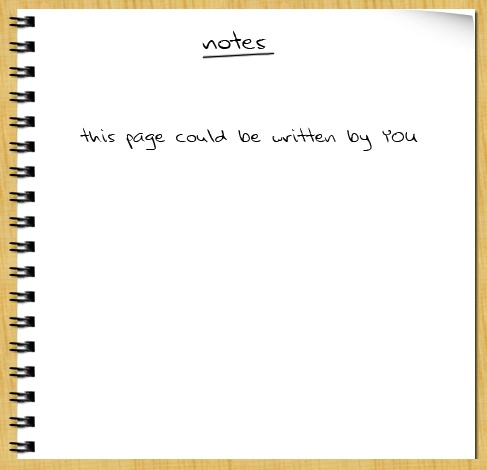
The fruit of these musings is (or will be… or is steadily becoming) “Novel Twists”, a ongoing collaborative fiction experiment where you, I or anyone can contribute a page. The only stipulations are that entries are between 250 and 450 words, are kept reasonably clean, and that you refrain from killing the protagonist, Andy Amaratha — at least at this early stage, when only 17 pages have been completed. Writers also get a little 100-word notepad beneath their page to provide a biographical sketch and author’s notes. Once they’ve published their slice, the subsequent page is auctioned on Ebay. Before too long, a final bid is accepted and the next appointed author has 24 hours to complete his or her page.
Networked vanity publishing, you might say. And it is. But McArthur clearly isn’t in it for the money: bids are made by the penny, and all proceeds go to a cancer charity. The Ebay part is intended more to boost the project’s visibility (an article in yesterday’s Guardian also helps), and “to allow everyone a fair chance at the next page.” The main point is to have fun, and to test the hunch that relay-race writing might yield good fiction. In the end, McArthur seems not to care whether it does or not, he just wants to see if the thing actually can get written.
Surrealists explored this territory in the 1920s with the “exquisite corpse,” a game in which images and texts are assembled collaboratively, with knowledge of previous entries deliberately obscured. This made its way into all sorts of games we played when we were young and books that we read (I remember that book of three-panel figures where heads, midriffs and legs could be endlessly recombined to form hilarious, fantastical creatures). The internet lends itself particularly well to this kind of playful medley.
on appropriation
The Tate Triennial 2006, showcasing new British Art, brings together thirty-six artists who explore the reuse and reshaping of cultural material. Curated by Beatrix Ruf, director of the Kunsthalle in Zurich, the exhibition includes artists from different generations who explore reprocessing and repetition through painting, drawing, sculpture, photography, film, installations and live work.
Historically, the appropriation of images and other cultural matter has been practiced by societies as the reiteration, reshuffling, and eventual transformation of artistic and intellectual human manifestations. It covers a vast range from tribute to pastiche. When visual codes are combined, the end product is either a cohesive whole where influences connect into new and very personal languages, or disparate combinations where influences compete and clash. In today’s art, the different guises of repetition, from collage and montage to file sharing and digital reproduction highlight the existing codes or reveal the artificiality of the object. Today’s combination of codes alludes to a collective sense of memory in a moment when memories have become literally photographic.
One comes out of this exhibition thinking about Duchamp‘s “readymades,” Rauschenberg’s “combines,” and other forms of conceptual “gluing,” (the literal meaning of the word “collage,”) as precursors and/or manifestations of the postmodern condition. This show is a perfect representation of our moment. As Beatrix Ruf says in the catalogue: “Artists today are forging new ways of making sense of reality, reworking ideas of authenticity, directness and social relevance, looking again into art practices that emerged in the previous century.”
We have artists like Michael Fullerton, who paints contemporary figures in the style of Gainsborough, or Luke Fowler‘s use of archive material to explore the history of Cornelius Cardew’s Scratch Orchestra. Repetition goes beyond inter-referentiality in the work of Marc Camille Chaimowicz, who combines works he made in the 70s with projected images of himself as a young man and as an adult, within a space where a vase of flowers set on a Marcel Breuer’ table and a pendulum swinging back and forth position the images of the past solidly in the present. In “Twelve Angry Women,” Jonathan Monk affixes to the wall twelve found drawings by an unknown artist from the 20s, using different colored pins that work as earrings. Mark Leckey uses Jeff Koons’ silver bunny as a mirror into his studio in the way 17th century masters painted theirs. Liam Gillick creates sculptures of hanging texts made out of factory signage.
Art itself is cumulative. Different generations build upon previous ones in a game of action and reaction. One interesting development in art today is the collective. Groups of artists coming together in couples, teams, or cyberspace communities, sometimes under the identity of a single person, sometimes a single person assuming a multiple identity. Collectives seem to be a new phenomenon, but their roots go back to the concept of workshops in antiquity where artistic collaboration and copying from casts of sculptural masterpieces was the norm. The notion of the individual artist producing radically new and original art belongs to modernity. The return to collectives in the second part of the 20th century, and again now, has a lot to do with the nature of representation, with the desire to go beyond the limits of artistic mimesis or individual interpretation.
On the other hand, appropriation as a form of artistic expression is a postmodern phenomenon. Appropriation is the language of today. Never before the advent of the Internet had people appropriated knowledge, spaces, concepts, and images as we do today. To cite, to copy, to remix, to modify are part of our everyday communication. The difference between appropriation in the 70s and 80s and today resides in the historical moment. As Jean Verwoert says in the Triennial 2006 catalogue:
The standstill of history at the height of the Cold War had, in a sense, collapsed the temporal axis and narrowed the historical horizon to the timeless presence of material culture, a presence that was exacerbated by the imminent prospect that the bomb could wipe everything out at any time. To appropriate the fetishes of material culture, then, is like looting empty shops at the eve of destruction. It is the final party before doomsday. Today, on the contrary, the temporal axis has sprung up again, but this time a whole series of temporal axes cross global space at irregular intervals. Historical time is again of the essence, but this historical time is not the linear or unified timeline of steady progress imagined by modernity: it is a multitude of competing and overlapping temporalities born from the local conflicts that the unresolved predicaments of the modern regimes still produce.
Today, the challenge is to rethink the meaning of appropriation in a moment when capitalist commodity culture has become the determinant of our daily lives. The Internet is perhaps our potential Utopia (though “dystopian” seems to be the adjective of choice now.) But, can it be called upon to fulfill the unfulfilled promises of 20th century’s utopias? To appropriate is to resist the notion of ownership, to appropriate the products of today’s culture is to expose the unresolved questions of a world shaped by the information era. The disparities between those who are entering the technology era and those forced to stay in the times of early industrialization are more pronounced than ever. As opposed to the Cold War, where history was at a standstill, we live in a time of extreme historicity. Permanence is constantly challenged, how to grasp it all continues to be the elusive task.
wealth of networks
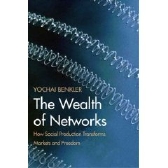 I was lucky enough to have a chance to be at The Wealth of Networks: How Social Production Transforms Markets and Freedom book launch at Eyebeam in NYC last week. After a short introduction by Jonah Peretti, Yochai Benkler got up and gave us his presentation. The talk was really interesting, covering the basic ideas in his book and delivered with the energy and clarity of a true believer. We are, he says, in a transitional period, during which we have the opportunity to shape our information culture and policies, and thereby the future of our society. From the introduction:
I was lucky enough to have a chance to be at The Wealth of Networks: How Social Production Transforms Markets and Freedom book launch at Eyebeam in NYC last week. After a short introduction by Jonah Peretti, Yochai Benkler got up and gave us his presentation. The talk was really interesting, covering the basic ideas in his book and delivered with the energy and clarity of a true believer. We are, he says, in a transitional period, during which we have the opportunity to shape our information culture and policies, and thereby the future of our society. From the introduction:
This book is offered, then, as a challenge to contemporary legal democracies. We are in the midst of a technological, economic and organizational transformation that allows us to renegotiate the terms of freedom, justice, and productivity in the information society. How we shall live in this new environment will in some significant measure depend on policy choices that we make over the next decade or so. To be able to understand these choices, to be able to make them well, we must recognize that they are part of what is fundamentally a social and political choice—a choice about how to be free, equal, productive human beings under a new set of technological and economic conditions.
During the talk Benkler claimed an optimism for the future, with full faith in the strength of individuals and loose networks to increasingly contribute to our culture and, in certain areas, replace the moneyed interests that exist now. This is the long-held promise of the Internet, open-source technology, and the infomation commons. But what I’m looking forward to, treated at length in his book, is the analysis of the struggle between the contemporary economic and political structure and the unstructured groups enabled by technology. In one corner there is the system of markets in which individuals, government, mass media, and corporations currently try to control various parts of our cultural galaxy. In the other corner there are individuals, non-profits, and social networks sharing with each other through non-market transactions, motivated by uniquely human emotions (community, self-gratification, etc.) rather than profit. Benkler’s claim is that current and future technologies enable richer non-market, public good oriented development of intellectual and cultural products. He also claims that this does not preclude the development of marketable products from these public ideas. In fact, he sees an economic incentive for corporations to support and contribute to the open-source/non-profit sphere. He points to IBM’s Global Services division: the largest part of IBM’s income is based off of consulting fees collected from services related to open-source software implementations. [I have not verified whether this is an accurate portrayal of IBM’s Global Services, but this article suggests that it is. Anecdotally, as a former IBM co-op, I can say that Benkler’s idea has been widely adopted within the organization.]
Further discussion of book will have to wait until I’ve read more of it. As an interesting addition, Benkler put up a wiki to accompany his book. Kathleen Fitzpatrick has just posted about this. She brings up a valid criticism of the wiki: why isn’t the text of the book included on the page? Yes, you can download the pdf, but the texts are in essentially the same environment—yet they are not together. This is one of the things we were trying to overcome with the Gamer Theory design. This separation highlights a larger issue, and one that we are preoccupied with at the institute: how can we shape technology to allow us handle text collaboratively and socially, yet still maintain an author’s unique voice?
more from USC conference: useful dichotomies for reconsidering scholarship in the digital era
from Tara McPherson:
– content/context
– practice/theory (practice as research in action)
– process/product (embrace productive failure)
– open/closed (what does versioning mean?)
– dialogue/argument (new ways of marshaling evidence; what does it mean when argument shifts into dialogue?)
– pedagogy/scholarship/service (tenure system is archaic; most non-traditional modes of scholarly inquiry are considered nothing more than community service)
– many/single (how do we rethink collaboration?)
– tools/theories (blurring that boundary)
Tara McPherson is Associate Professor of Gender and Critical Studies; Chair, Division of Critical Studies, School of Cinema-Television, USC; and editor of the forthcoming Vectors, an electronic peer-reviewed journal.



